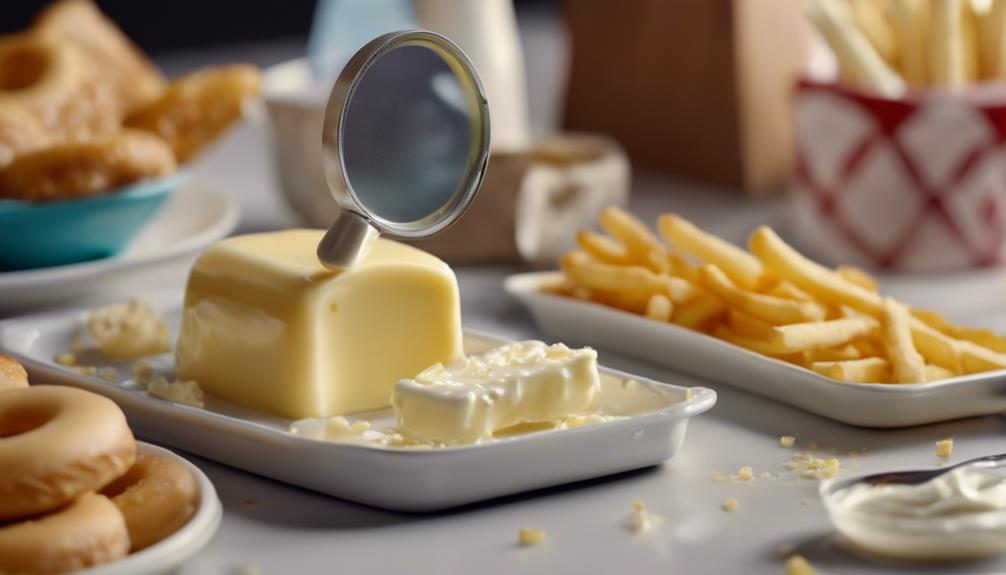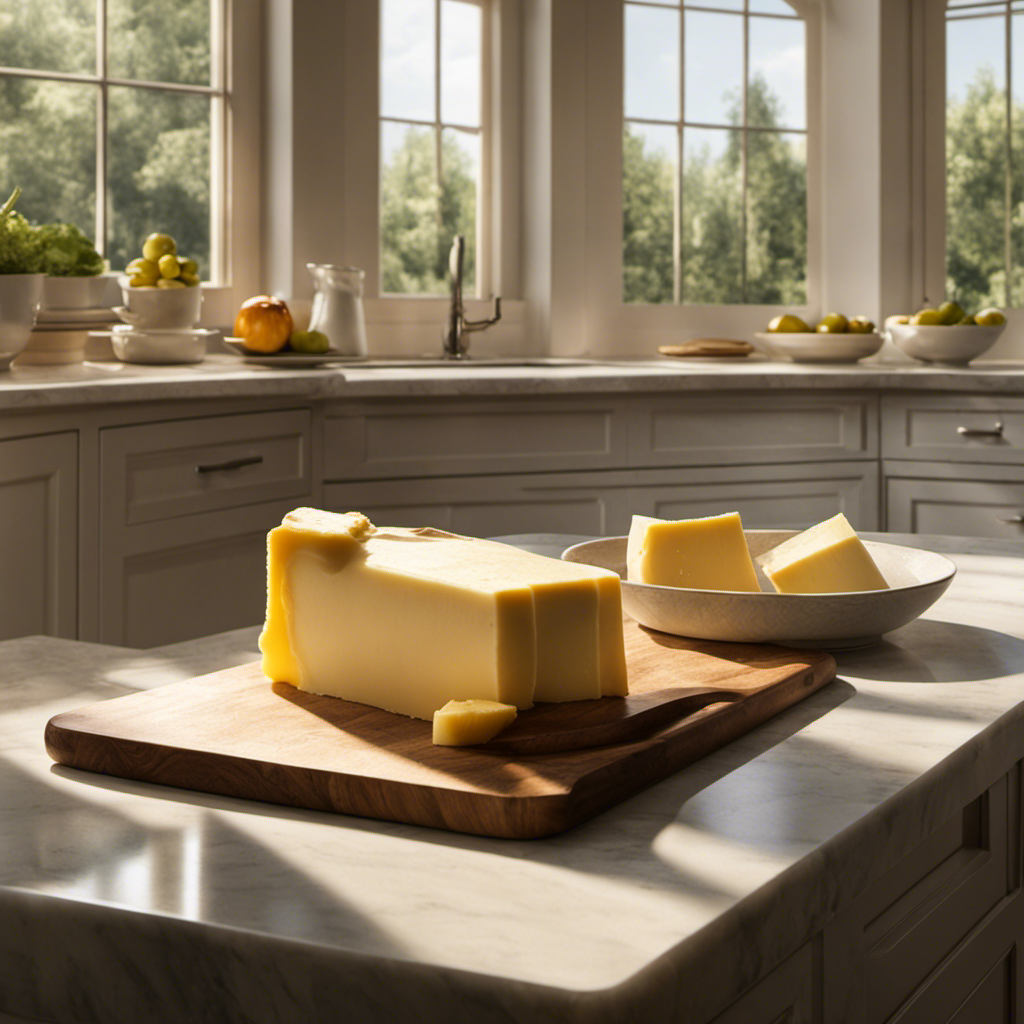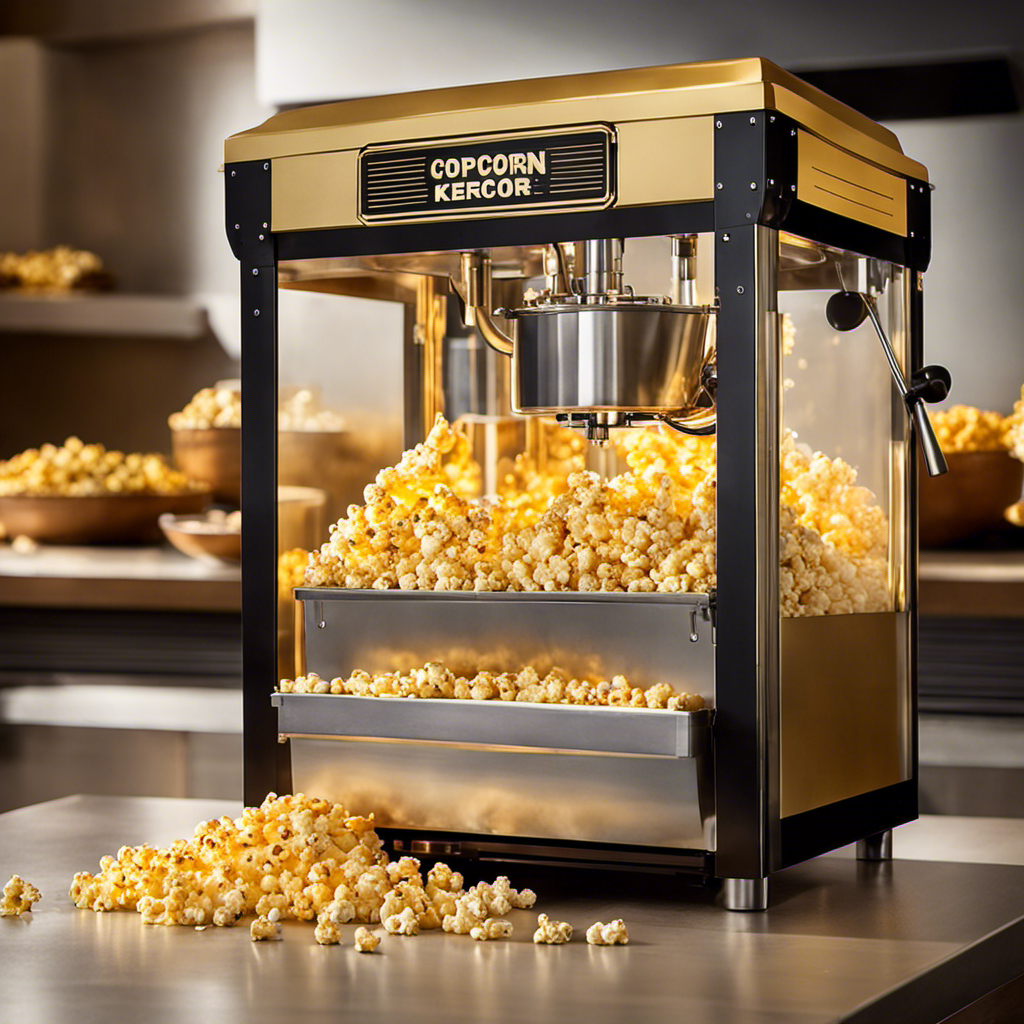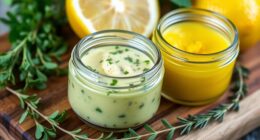Oh boy, I’ve got to tell you about ramp butter! It’s like a flavor explosion in your mouth. This stuff is truly amazing.
I mean, we’re talking about butter that’s infused with the unique and pungent taste of ramps. You know, those wild leeks that are bursting with flavor? Well, imagine that flavor blended perfectly into creamy, smooth butter. It’s a game-changer, my friends.
In this article, we’re going to dive deep into the origins, nutritional benefits, and even how to make ramp butter at home. Trust me, you don’t want to miss this.
Key Takeaways
- Ramp butter is made from ramps, which are wild leeks that grow in North America.
- Ramp butter is a healthier alternative to spreads like margarine or butter, as it is lower in saturated fat and cholesterol.
- Consuming ramp butter can support a healthy immune system and promote good bone health.
- Ramp butter is a delicious and nutritious option, providing a rich and creamy taste, while being lower in saturated fat and cholesterol.
Origins of Ramp Butter
You might be wondering where ramp butter comes from.
Ramp butter is made from ramps, which are wild leeks that grow in North America. These flavorful plants have a long history of culinary use, dating back to Native American tribes who used them for both their taste and medicinal properties.
Ramps are foraged in the spring when they emerge from the forest floor. The bulbs and leaves are harvested and then processed into ramp butter. This butter is a delicious condiment that adds a unique, garlicky flavor to dishes.
In addition to its taste, ramp butter also offers health benefits. It is rich in vitamins A and C, as well as minerals like iron and calcium. Consuming ramp butter can support a healthy immune system and promote good bone health.
Nutritional Benefits of Ramp Butter
As a nutritionist, I’m excited to discuss the nutritional benefits of ramp butter.
Ramp butter is not only a healthier alternative to spreads like margarine or butter, but it also boosts the immune system and is rich in essential nutrients.
This unique spread is packed with vitamins and minerals that promote overall health and well-being.
Healthier Alternative to Spreads
When looking for a healthier alternative to spreads, consider trying ramp butter. Ramp butter is a delicious and nutritious option that offers numerous health benefits. Not only does it provide a rich and creamy taste, but it also contains essential vitamins and minerals. Compared to traditional spreads like margarine, ramp butter is lower in saturated fat and cholesterol, making it a heart-healthy option. Additionally, ramp butter is a good source of antioxidants, which can help protect against oxidative stress and inflammation in the body.
To emphasize the health benefits of ramp butter, here is a comparison table:
| Health Benefits of Ramp Butter | |
|---|---|
| Lower in saturated fat and cholesterol | Heart-healthy option |
| Rich in vitamins and minerals | Essential for overall health |
| Good source of antioxidants | Protects against oxidative stress and inflammation |
Boosts Immune System
Boosting your immune system is important for overall health and well-being. A strong immune system helps to protect your body against harmful pathogens and reduces the risk of illness.
There are several ways to support and enhance your immune system, such as maintaining a healthy diet and lifestyle. Consuming foods that are rich in vitamins, minerals, and antioxidants can provide the necessary nutrients to strengthen your immune system.
Additionally, regular exercise boosts energy levels and promotes the efficient functioning of your immune system. Proper digestion is also crucial for a strong immune system. A balanced diet that includes fiber-rich foods, probiotics, and prebiotics supports digestion and enhances immune function.
Rich in Essential Nutrients
To optimize your immune system and improve your overall health, consuming foods rich in essential nutrients is essential. When it comes to boosting your immune system, there are several key nutrients that play a crucial role.
Some of the essential nutrients found in certain foods include:
-
Vitamin C: Found in citrus fruits, strawberries, and bell peppers, vitamin C helps stimulate the production of white blood cells, which are essential for fighting off infections.
-
Zinc: Foods like oysters, beef, and pumpkin seeds are rich in zinc, which is known to enhance the immune system’s ability to fight off viruses and bacteria.
-
Omega-3 fatty acids: These healthy fats can be found in fatty fish like salmon, chia seeds, and walnuts. Omega-3s help reduce inflammation in the body and support overall immune function.
Incorporating these nutrient-rich foods into your diet can provide numerous health benefits and help optimize your immune system. If you’re looking for delicious and nutritious recipes, consider trying a citrus fruit salad with strawberries, bell peppers stuffed with lean beef, or a salmon and chia seed salad. By including these foods in your meals, you can support your immune system and improve your overall health.
How to Make Ramp Butter at Home
You can easily make ramp butter at home by combining fresh ramps with softened butter and a pinch of salt. Ramps, also known as wild leeks, have a unique flavor that is a combination of garlic and onion. When incorporated into butter, they add a delicious and distinctive taste to your favorite dishes.
To make ramp butter, finely chop the ramps and mix them with softened butter and a pinch of salt. You can also experiment with different flavor variations by adding herbs like thyme or chives.
Once prepared, ramp butter can be stored in an airtight container in the refrigerator for up to two weeks. Its shelf life can be extended by freezing it in small portions.
This homemade butter is a versatile and flavorful addition to your culinary repertoire.
Ways to Incorporate Ramp Butter in Your Recipes
When it comes to incorporating ramp butter into your recipes, there are several key points to consider.
First, the unique flavor pairings that ramp butter offers can elevate any dish to a whole new level.
Additionally, ramp butter’s versatility allows for a wide range of culinary applications, making it a must-have ingredient in any kitchen.
Lastly, by adding ramp butter to traditional dishes, you can enhance their flavors and create a memorable dining experience.
Unique Flavor Pairings
Indulge in the delightful combination of ramp butter and other unique flavor pairings. As a culinary enthusiast, I’ve always been fascinated by the art of flavor combinations and culinary experimentation. When it comes to ramp butter, the possibilities are endless.
Here are three sub-lists of flavor pairings that will elevate your dishes to a whole new level of sophistication:
-
Sweet and Savory:
-
Pair ramp butter with honey for a sweet and tangy spread.
-
Combine it with caramelized onions for a rich and savory topping.
-
Mix it with roasted garlic for a sweet and garlicky flavor explosion.
-
Spicy and Tangy:
-
Add a kick to your ramp butter by mixing it with sriracha sauce.
-
Combine it with lime zest for a tangy and refreshing twist.
-
Mix it with crushed red pepper flakes for a fiery and zesty flavor.
-
Earthy and Herbaceous:
-
Pair ramp butter with fresh thyme for an earthy and aromatic spread.
-
Combine it with rosemary for a fragrant and herbaceous flavor.
-
Mix it with sage for a savory and comforting taste.
These flavor combinations will take your culinary creations to new heights, allowing you to explore the diverse and unique flavors that ramp butter has to offer. So go ahead, unleash your inner chef, and embark on a journey of culinary innovation.
Versatile Culinary Applications
After exploring unique flavor pairings, I’m excited to dive into the versatile culinary applications of ramp butter. This delightful condiment is a true embodiment of culinary creativity, offering endless possibilities to enhance flavors in various dishes.
Ramp butter can be used as a spread on bread or toast to elevate the taste of a simple breakfast. It can also be melted and drizzled over vegetables, adding a rich and savory note to roasted or steamed greens. For a flavor-packed pasta dish, toss cooked pasta with ramp butter, grated Parmesan cheese, and a sprinkle of black pepper.
Additionally, ramp butter can be incorporated into sauces and dressings, enhancing their taste profiles and giving a unique twist to familiar recipes. Its robust flavor and creamy texture make it a versatile ingredient that adds depth and complexity to any dish.
Get creative in the kitchen and explore the endless possibilities of ramp butter for flavor enhancement.
Enhancing Traditional Dishes
To enhance traditional dishes, you can incorporate ramp butter into classic recipes, adding a unique twist and elevating the flavors. The rich and earthy taste of ramps, combined with the creamy and smooth texture of butter, creates a harmonious blend that enhances flavor profiles in a way that is both sophisticated and innovative.
When using ramp butter, consider the following:
- Use it as a spread on warm crusty bread, allowing the flavors to meld together and create a delicious appetizer.
- Melt a dollop of ramp butter over grilled vegetables or roasted meats for a burst of flavor that will take your dish to the next level.
- Incorporate ramp butter into sauces or dressings to add depth and complexity to your culinary creations.
Health Benefits of Consuming Ramp Butter
Consuming ramp butter can provide various health benefits. Ramp butter is not only a delicious addition to meals, but it is also packed with nutrients that promote overall well-being.
| Health Benefit | Description |
|---|---|
| Rich in Antioxidants | Ramp butter contains high levels of antioxidants, which help fight against free radicals and reduce oxidative stress. |
| Boosts Immune System | The presence of vitamins, minerals, and phytochemicals in ramp butter can enhance the immune system and protect against illnesses. |
| Supports Digestion | Ramp butter is a good source of fiber, promoting healthy digestion and preventing constipation. |
| Heart-Healthy | The monounsaturated fats found in ramp butter can help lower cholesterol levels and reduce the risk of heart disease. |
| Anti-inflammatory | The sulfur compounds in ramps possess anti-inflammatory properties, which can help alleviate symptoms of inflammatory conditions. |
In addition to its health benefits, ramp butter also has various culinary uses. It can be used as a spread on bread, a topping for grilled meat or vegetables, or even as a flavor enhancer in sauces and dressings. Incorporating ramp butter into your diet can not only add a burst of flavor, but also provide numerous health benefits.
Unique Flavors and Uses of Ramp Butter
When incorporating it into your meals, you will discover the unique flavors and culinary uses of ramp butter. Ramp butter is a flavorful condiment that adds a burst of earthy, garlicky taste to any dish.
Here are some creative recipe ideas to enhance your culinary experience with ramp butter:
- Spread ramp butter on a warm baguette for a delicious appetizer.
- Use ramp butter as a base for sautéing vegetables to elevate their flavors.
- Melt ramp butter over grilled steak or seafood for a rich and savory finish.
Ramp butter is a versatile ingredient that can be used in various dishes, from pasta and risotto to roasted vegetables and grilled meats. Its distinct taste adds depth and complexity to your recipes.
Experiment with different combinations to create unique and mouthwatering dishes. Enjoy the exquisite flavors that ramp butter brings to your meals.
Frequently Asked Questions About Ramp Butter
Have you ever wondered about the best ways to incorporate this versatile ingredient into your favorite recipes? Ramp butter, made from the leaves and bulbs of wild ramps, adds a unique and flavorful twist to a variety of dishes. Whether you’re looking to enhance the taste of roasted vegetables, elevate the flavor of grilled meats, or simply spread it on a slice of crusty bread, ramp butter is a delicious and versatile option.
To help you make the most of this culinary delight, here are a few ramp butter recipes and storage tips:
| Recipe | Description |
|---|---|
| Roasted Potatoes | Toss quartered potatoes in ramp butter, salt, and pepper, then roast until crispy and golden brown. |
| Grilled Salmon | Brush ramp butter on salmon fillets before grilling for a flavorful and moist seafood dish. |
| Pasta Sauce | Melt ramp butter with garlic, lemon juice, and Parmesan cheese for a creamy and tangy pasta sauce. |
| Garlic Bread | Spread ramp butter on slices of French bread, sprinkle with garlic powder, and toast until golden brown. |
Storage Tips for Ramp Butter:
- Store ramp butter in an airtight container in the refrigerator for up to two weeks.
- Alternatively, freeze ramp butter in small portions for future use.
- Label and date your ramp butter to keep track of its freshness.
With these recipes and storage tips, you’ll be able to enjoy the delicious flavors of ramp butter in various dishes while ensuring its longevity. Happy cooking!
Frequently Asked Questions
Can Ramp Butter Be Used as a Substitute for Regular Butter in Recipes?
Yes, ramp butter can be used as a substitute for regular butter in recipes. It adds a unique flavor to dishes and can be used in various cooking methods. Additionally, ramp butter offers health benefits such as being rich in vitamins and antioxidants.
How Long Does Ramp Butter Last in the Refrigerator?
Ramp butter lasts about 2-4 weeks in the fridge. To ensure its freshness, store it in an airtight container. Proper storage is key to maintaining the quality and extending the shelf life of ramp butter.
Can Ramp Butter Be Frozen for Later Use?
Yes, ramp butter can be frozen for later use. It is important to store it properly in an airtight container to maintain its freshness. When thawed, it can be used in various recipes, adding a unique flavor to dishes.
Are Ramps and Wild Leeks the Same Thing?
Ramps and wild leeks may seem similar, but they have distinct differences. While both are delicious and nutritious, they vary in taste and appearance. Understanding their nutritional value is essential for culinary and scientific purposes.
Are There Any Potential Allergies or Sensitivities to Ramp Butter?
There may be potential allergies or sensitivities to ramp butter, as with any food. It’s important to be aware of any reactions and consult a healthcare professional if needed.
Conclusion
In conclusion, ramp butter is a hidden gem in the culinary world. Its origins lie in the wild ramps found in the forests, giving it a unique flavor and aroma. This butter is not only delicious but also packed with essential nutrients, making it a healthy choice.
By following a simple recipe, you can easily make ramp butter at home and incorporate it into various dishes. Its distinct taste adds a touch of magic to any recipe, symbolizing the beauty of nature’s bounty.
So why not indulge in this flavorful delight and reap the health benefits it offers?









